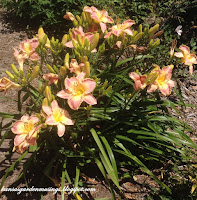
Today's blog was guest submitted by Dr. Ranida Phobia in lieu of ProfessorRoush who is currently
under treatment er, uh, "indisposed":
When I first saw him this morning, ProfessorRoush seemed unusually jittery, eyes darting feverishly left and right, up and down, his limbs as restless as a puppet under the direction of a seizuring master.
"What's going on?" I asked.
"Ssshhh, they'll hear you!" ProfessorRoush frantically whispered. He was haggard, unshaved, and his face was flushed.
"Who'll hear me?"

"The frogs, the darned tree frogs," he replied, "They're everywhere."
"So what?"
"They're freaking me out, man. They're always there, watching me, perching on everything and watching me work. Sitting on the porch railing, sitting on the windowsills...."
"Easy, buddy, they're just frogs."
"No, no, no! I'm telling you, these are different. They're more focused-like. I think these frogs are intelligent, smarter than before, see, and they're observing us, taking notes and probably reporting back to their frog overlords."

"Ah, c'mon, There are just a few more out there now because we've had a wet spring," I said, as I began to ease out of reach of the trowel ProfessorRoush was clenching.
"That's it, exactly! They must have reached a population density that allowed their collective consciousness to bind and amped up their intelligence. They're planning now, something's gonna happen, I just know it. The other day, one was just waiting for me, perched on a faucet handle I was reaching for. Probably would have grabbed my arm and chewed it off, man. I jumped a mile high when I saw it."
"Calm down, calm down. I'm sure it's all just a coincidence and you'll feel better once the weeding slows down and you get some rest." I felt the best approach was to keep my voice low and level and back away from ProfessorRoush as he began to flex his biceps and his eyes began bulging out.
"I think it's global warming," he whispered. "I think all the Birkenstock-wearing WEE (author's note: he means Wild-Eyed Environmentalists) are right about us changing the climate and the world. And the frogs are the first sign, but where they were going extinct before, now they've realized that global warming is good for them in Kansas, brings them more rain, and they're expanding their reach, getting ready to take over from us. It's the dinosaurs all over again, man. Except that we're the dinosaurs."

"Oh, that's probably pretty unlikely, pal. Let me call someone and ask about it for you, okay?"
"Look, there's one right there. He climbed 20 feet right up that brick wall, just to spy on us. Don't you see what's happening?" ProfessorRoush began to run now, heading for the front door, slashing the air with the trowel, shouting "They're already here, you're next, you're next!" as he ran.
Sad, but relieved of fears for my personal safety, I watched ProfessorRoush run inside. The 911 operator was very calm and polite and said they'd send some help right over.
At least I think that was the response. We didn't have the best connection. The operator sounded like he was calling from the bottom of a well and his voice was a little hoarse, like he had a frog in his throat.























































